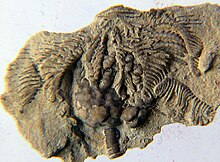Camerata (Crinoidea)
| Camerata Temporal range:
| |
|---|---|

| |
| , a sea lily of the family Rhodocrinidae, 16mm measured along the stem fragment and including cup and arms, collected at the Gilmore City Formation, near Gilmore City Iowa, USA, from the Lower Mississippian Carboniferous (Tournaisian) | |
| Scientific classification | |
| Kingdom: | |
| Phylum: | Echinodermata
|
| Subphylum: | |
| Class: | |
| Subclass: | †Camerata |
| Orders | |
The Camerata or camerate crinoids are an extinct subclass of Paleozoic stalked crinoids. They originated during the Early Ordovician, reached their maximum diversity during the Mississippian and became extinct during the Permian–Triassic extinction event.[2]
Anatomically, they are distinguished by:[3]
- fused junctions between the plates of the cup
- brachial plates incorporated into the cup
- tegmen forming a rigid roof over the mouth
- no less than ten and sometimes a very large number of free arms, often pinnulate
References[]
- ^ Revision of the Palaeocrinoidea...: Discussion of the classification and relations of the brachiate crinoids and conclusion of the generic descriptions. Partie 3 de Revision of the Palaeocrinoidea, Revision of the Palaeocrinoidea. Charles Wachsmuth and Frank Springer, Collins, printer, 1885
- ^ Bibliography and index of Paleozoic crinoids, coronates, and hemistreptocrinoids, 1758–1999. G. D. Webster. Geological Society of America Special Papers, vol. 363, 2003.
- ^ Treatise on Invertebrate Paleontology, Volume T. Echinodermata: Crinoidea. Ubaghs et al. Editors: R. C. Moore and C. Teichert. 1978.
External links[]
- Camerata in the Paleobiology Database
| Wikispecies has information related to Camerata. |
| Wikimedia Commons has media related to Camerata. |
Categories:
- Camerata (Crinoidea)
- Devonian crinoids
- Late Devonian animals
- Carboniferous crinoids
- Silurian crinoids
- Middle Devonian first appearances
- Late Devonian extinctions
- Crinoidea stubs
- Prehistoric echinoderm stubs